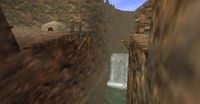Gerudo Valley
| Gerudo Valley | |
|---|---|
{{{content1}}}
{{{content2}}} Gerudo Valley as it appears in Smash. 
| |
| Universe | The Legend of Zelda |
| Appears in | SSB4 (3DS) Ultimate |
| Availability | Starter |
| Crate type | Normal |
| Maximum players | 4 (3DS) 8 (Ultimate) |
| Article on Zelda Wiki | Gerudo Valley |
Gerudo Valley (ゲルドの谷, Gerudo Valley) is a stage in Super Smash Bros. for Nintendo 3DS and Super Smash Bros. Ultimate. It is one of two stages from the Zelda universe in Super Smash Bros. for Nintendo 3DS, alongside Spirit Train.
In Smash 3DS, Ganondorf is fought here for his unlocking battle and in Ultimate, Sheik is fought here for her unlocking battle.
Stage overview
The Gerudo Valley stage is a mostly flat, grounded stage. The stone and natural flooring serve as solid platforms, and a bridge crosses the chasm between the two stretches of land. Two canopies stand on each piece of land, providing soft platforms featuring the Gerudo symbol for characters to stand on.
The central bridge can be destroyed by attacking it, similarly to the floor of Green Hill Zone: this allows access to the chasm below, and makes the bottom blast line move downwards to compensate. Two small platforms, which can also be broken by attacks, protrude from each side of the chasm, as well as some damaging spikes which disappear when hit and do flame damage.
Soon after the bridge is broken, Koume and Kotake fly down laughing, and one of them casts a spell which alters one half of the stage: Koume's spell hits the left side of the stage covering it in damaging flames, while Kotake's spell hits the right side making freezing ice spikes appear. However in 3DS the bridge can be broken without causing Koume and Kotake to appear and the bridge can disappear naturally
After a while, the "Song of Time" will be heard and the bridge will repair itself: this returns the blast line back to its default position, KO'ing any fighters who do not return to the surface quickly enough. In earlier versions of the game the blast line moved rather abruptly, KO'ing fighters almost instantly as a result: this has been changed in Version 1.0.5, and players are now given a bit more time to recover before the camera returns to the default position.
The background of the stage features a waterfall, the Carpenters' tent, and, behind the mountains in the left side, Gerudo's Fortress and the Horseback Archery Range. A desert wind will blow across the stage for aesthetic effect.
Ω forms and Battlefield form
In Super Smash Bros. for Nintendo 3DS, the Ω form is set on a completely flat platform that extends below the blast line that also has the Gerudo symbol as the floor pattern.
In Super Smash Bros. Ultimate, the main platform of the Ω form and Battlefield form is a slightly redesigned version of SSB4's Ω form; however, it does not extend below the blast line and is resized and reshaped to match Final Destination and Battlefield, respectively. The three soft platforms of the Battlefield form resemble the flooring of the Ω form.
Hazards Off
With hazards off in Ultimate, the bridge cannot be attacked or broken, and Koume and Kotake never appear.
Origin
- See also: Kotake and Koume.
This stage is based on Gerudo Valley from The Legend of Zelda: Ocarina of Time. It is a long, deserted valley that acts as the gateway to the domain of the Gerudo, and Link has to traverse it in order to reach Gerudo's Fortress and the Haunted Wasteland. Aesthetically, this stage is more similar to how Gerudo Valley appears in the remake, The Legend of Zelda: Ocarina of Time 3D.
In Ocarina of Time, the Gerudo decided to destroy the bridge over Zora's River to prevent intruders from entering their land. Carpenters then set up a camp nearby and attempted to repair it; however, they were later captured by the Gerudo and held captive in their fortress. After Link infiltrates the fortress and rescues them all, the bridge is finally repaired.
The symbol on the platforms represents the Gerudo tribe. In the original Ocarina of Time it was different, but it was replaced with the current version in all subsequent games (including ports and remakes of Ocarina) due to its resemblance to the Islamic star and crescent.
Gallery
Super Smash Bros. for Nintendo 3DS
Gerudo Valley in Super Smash Bros. for Nintendo 3DS.
A clearer view of the lower part of the stage, with spikes visible in SSB4.
A close-up of Kotake and Koume in SSB4.
Super Smash Bros. Ultimate
Ken alongside Koume on the stage.
Trivia
- In Ultimate's Classic Mode, Zelda & Marth are the only fighters who face a non-Zelda character for an opponent for each of their routes on Gerudo Valley. Both being Ridley and Dark Samus.
- On the flipside, Sheik & Ganondorf are the only two characters of Gerudo Valley's home universe to be fought as opponents for other characters in Classic Mode.
- Ness, Young Link, and Isabelle are the only characters who each face Sheik, while Link and Captain Falcon are the only ones who fight Ganondorf in their respective routes.
- Young Link is also the only fighter to travel to Gerudo Valley in its Ω form.
















